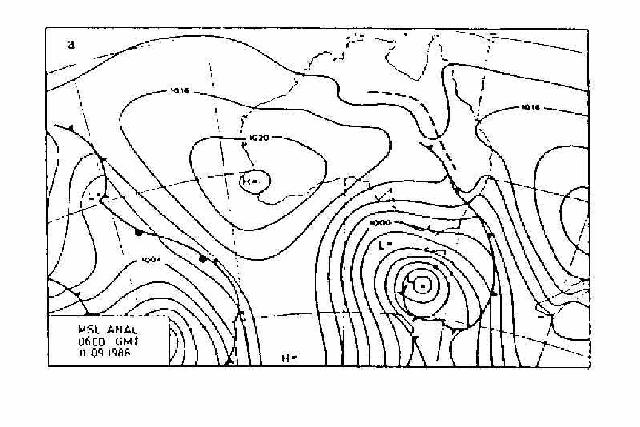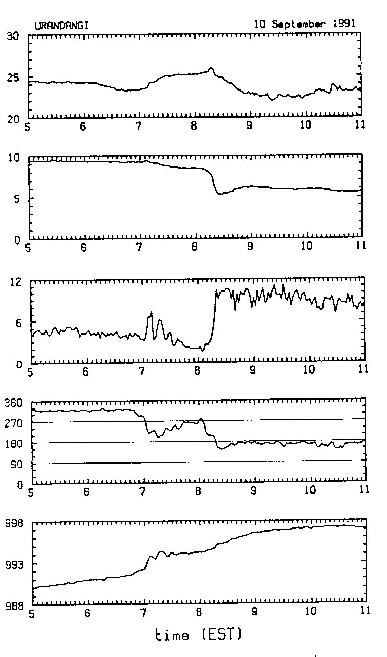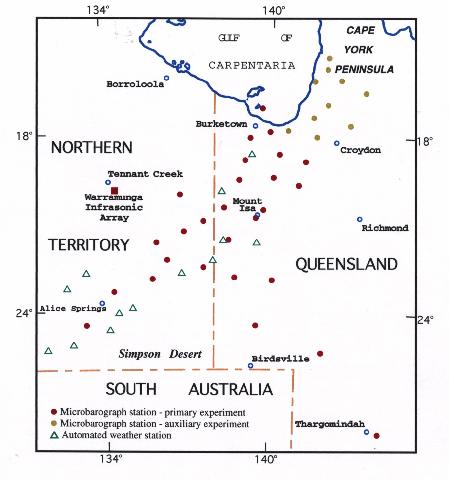This is long term project designed to better understand
the behaviour of cold fronts across the Australian subtropics.
BACKGROUND TO THE RESEARCH
This project represents a culmination of research over
the last decade into mesoscale atmospheric circulations over northeastern
Australia and into cold fronts (or cool changes) in southeastern Australia
(for a review see Reeder and Smith, 1992). Questions on subtropical fronts
arose through attempts to determine the structure and origin of nocturnal
wind surges in the southern part of the Gulf of Carpentaria region of northern
Australia. On occasion, these surges lead to spectacular cloud formations,
the so-called ‘morning glory’ phenomenon, but they are of fundamental meteorological
interest also, being the example par excellence of undular bore-wave disturbances
in the lower atmosphere; they form also a significant analysis and forecasting
problem over central Australia including the northwestern parts of Queensland.
These bore-like disturbances are the atmospheric equivalent of undular
bores on tidal rivers. Recent reviews are given by Smith (1988) and Christie
(1992).
Morning glory wind surges are known to originate predominantly
from two directions; from the northeast and from the south. Our earlier
research has shown that northeasterly surges are generated by the collision
of the east and west coast sea breezes over Cape York Peninsula, but the
generation mechanism for southerly surges is less certain. Physick and
Tapper (1990) have shown that the large salt lakes of central Australia
are possible sources of these solitary waves, but there is strong evidence
that many, but not all southerly surges are associated with the passage
of cold fronts across central Australia. Another possibility is that some
surges are generated by the nocturnal low-level jet associated with the
inland heat trough (Smith et al., 1986).
Attempts to determine the origin of southerly surges raised
fundamental questions concerning the structure and dynamics of the inland
trough, the structure and dynamics of subtropical cold fronts, and the
mechanism of interaction between an advancing frontal trough and the inland
trough. These are important questions vis-á-vis the meteorology
of the Australian subtropics, but they have received relatively little
study until recently, partly because the routine data base is totally inadequate
for this purpose.
THE CENTRAL AUSTRALIAN FRONTS EXPERIMENT (CAFE)
The Central Australian Fronts Experiment (CAFE) was organized
to provide a data set on subtropical cold fronts that could be used to
answer some of the basic questions about frontal structure and behaviour
and to help confirm or reject predictions obtained from model simulations.
The experiment ran from 7 September until 4 October 1991 and documented
three cold fronts over central and northeastern Australia in unprecedented
detail, with data obtained from a greatly enhanced surface observing network,
a boundary-layer wind profiler as well as serial upper air soundings. Data
on the surface energy balance were obtained also. The findings of the experiment
are reported by Smith et al. (1995).
As a preliminary to the CAFE experiment, a very modest
pilot experiment (pre-CAFE) was organized in September 1988 to investigate
the vertical structure of cold fronts as they passed over Mount Isa (21S,
139E). Three frontal passages were documented during pre-CAFE and the results
are reported by Smith and Ridley (1990).
THE STRUCTURE OF DRY SUBTROPICAL COLD FRONTS
A common feature of all six fronts documented during CAFE
and pre-CAFE was that they were dry, shallow ( ~ 1 km deep) and moved into
a deep ( ~ 4 km) convectively-well-mixed boundary layer. During the night,
the well-mixed layer was terminated below by a strong, but shallow radiation
inversion. One of the fronts initiated major dust storms across central
Australia.
The synoptic environment of these fronts was similar to
that of the summertime ‘cool-change’ of southeastern Australia with frontogenesis
occurring in the col region between the two subtropical anticyclones, relatively
far from the centre of the parent cyclone. A unique feature of the region
is the presence of a heat trough over northeastern Queensland with which
the frontal trough eventually merges. Generally, the frontal passage is
followed by strong ridging from the west.
A typical mean sea level chart with a cold front (indicated
in the analysis by a dashed line) extending into central Australia. The data obtained during the CAFE experiment highlighted
the large diurnal variation of frontal structure associated with diabatic
processes. The fronts were difficult to locate during the late morning
and afternoon when dry convective mixing was at its peak, but developed
strong surface signatures in the evening as the convection subsided and
a surface-based radiation inversion developed. Moreover, there appeared
to be a ubiquitous tendency in the early morning for the formation of non-linear
wave-like or bore-like structure at the leading edge of the frontal zone
as the inversion strengthened. In each case, as the wave/bore developed,
it was observed to propagate ahead of the air mass change on the pre-existing
inversion. Such behaviour was exemplified by the data for the first two
events during CAFE. In the latter case, the data are unique in providing
the first clear evidence of the formation of a southerly morning glory
bore-wave in the Gulf of Carpentaria region from a cold front in the south.
The passage of a bore brings a strong, but temporary wind surge at the
surface accompanied by a sharp pressure jump. These are follows by a series
of wind and pressure oscillations with a period of 10-15 min, before the
steadier post-frontal airflow is established. There is no air mass change
with the passage of the bore, but the vigorous turbulence that accompanies
it may lead to a breakdown of any shallow radiation inversion that exists,
often causing a rise in surface temperature.
Surface data from Urandangi for the first frontal passage
during the CAFE experiment. The panels show from top to bottom: the temperature
in deg. C, the water vapour mixing ratio in gm/kg, the wind speed in m/sec
, the wind direction, and the pressure in mb. Note the undular bore-like
disturbance that occurs about 0700 Eastern Australian Time (EST). Its passage
is marked by sharp jumps in pressure and temperature, a sharp change in
wind direction from WNW to SW and a marked freshening of the wind. The
temperature rise is a result of the destruction of the shallow nocturnal
radiation inversion as the wind freshens. The passage is followed by regular
fluctuations in pressure and in wind speed and direction for three quarters
of an hour. The passage of the cold front, itself, is indicated by the
sharp increase in wind speed and a further backing of the wind about 0815
EST. Following this, the temperature begins to decline steadily, the pressure
begins a steady rise and the mixing ratio falls sharply.
A climatological study of cold fronts over central Australia,
based on routine data for 1992 and 1993, is currently in progress.
THE CENTRAL AUSTRALIAN FRONTS EXPERIMENT 1996 (CAFE96)
It is interesting that none of the three CAFE fronts had
an obvious surface signature at Alice Springs, but that the initial appearance
of a pressure jump occurred in each case within two hundred kilometres
to the east of the town. It is not clear whether this is a feature of the
local orography, but if so it would have implications for the representatives
of data at this station for the analysis of cold fronts.
Unfortunately, the surface network during CAFE was too
sparse to enable the formation of a sharp pressure jump in the early evening
to be properly documented and it was not adequate to enable the motion
of the air mass boundary to be adequately determined. For this reason a
third experiment (CAFE96) was organized in 1986 to investigate these features
in greater detail. It was carried out in the region between Giles in Western
Australia and Burketown in northwestern Queensland from the end of August
until early October 1996. It was organized by Monash University, The Australian
National University, the University of New South Wales and the University
of Munich, Germany, with collaborative support of the Bureau of Meteorology’s
Northern Territory Regional Office.
One of the principal findings from CAFE was that the Mount
Isa region, the focus for CAFE, is near to the latitude at which non-linear
waves are generated and where the fronts are strongly modified by the nocturnal
inversion. Consequently, the data there difficult to interpret in relation
to the air mass change. For this reason, the focus of CAFE96 was moved
southwestward towards Alice Springs.
A primary objective of the CAFE96 experiment was to obtain
high resolution surface data on cold fronts as they traverse central Australia
in order to document in more detail than has been possible to date the
generation of the wave disturbance. A second objective is to better understand
the meteorology of central Australia where there are large diurnal effects
governing the principal wind-producing systems.
For the experiment, a special network of surface measuring
stations was installed in the normally data void region between Yulara
and Mount Isa and between Mount Isa and Burketown. These included fourteen
automatic weather stations recording wind speed, wind direction, temperature,
wet-bulb temperature and pressure. They were interspersed with over thirty
high resolution micropressure and temperature recording stations operated
by the Australian National University. These recording stations were deployed
along a southwest/northeast oriented line between Giles and the lower Cape
York Peninsula and also along a southeast/northwest orientated line between
Birdsville and the Granites mine in the Tanami Desert.
Station network for the CAFE96 Experiment Surface stations Seven fronts were documented during the experiment which
ran from 31 August to 5 October, 1996. Preliminary results confirm the
ubiquity of nocturnal wave generation suggested by previous studies and
provide further examples of the strong frontolysis that occurs during the
day; the nocturnal separation of a wave disturbance from the air-mass boundary;
and the generation of ‘southerly morning glories’ in the Gulf of Carpentaria
region. Scientific papers describing the results are in preparation.
THEORETICAL STUDIES
Numerical modelling studies are being carried out at Monash
University, the University of New South Wales and the University of Munich
to investigate the frontolysis of subtropical cold fronts during the daytime
and their re-intensification during the evening as well as their evolution
into non-linear wave- or bore-like disturbances.
REFERENCES
Christie, D. R., 1992: The morning glory of the Gulf of
Carpentaria: A paradigm for nonlinear waves in the lower atmosphere. Aust.
Meteor. Mag., 41, 21-60.
Physick, W. L. and N. J. Tapper, 1990: A numerical study
of circulations induced by a dry salt lake. Mon. Wea. Rev., 118, 1029-1042.
Reeder, M. J. and R. K. Smith, 1992: Australian spring
and summer cold fronts. Aust. Meteor. Mag., 41, 101-124.
Smith, R. K., 1988: Waves and bores in the lower atmosphere:
the ‘morning glory’ and related phenomena. Earth Sci. Rev., 25, 267-290.
Smith, R. K. and R. N. Ridley, 1990: Subtropical continental
cold fronts. Aust. Meteor. Mag., 38, 191-200.
Smith, R. K., M. J. Coughlan, and J. Evans-Lopez, 1986:
Southerly nocturnal wind surges and bores in northeastern Australia. Mon.
Wea. Rev., 114, 1501-1518.
Smith, R. K., M. J. Reeder, N. J. Tapper, and D. R. Christie,
1995: Central Australian cold fronts. Mon. Wea. Rev., 123, 16-38.
M. J. Reeder and R. K. SMITH, 1998: Mesoscale meteorology
in the Southern Hemisphere. Chapter 5
M. J. Reeder, R. K. SMITH, R. Deslandes, N. J. Tapper
and G. A. Mills, 2000: Subtropical fronts
Date 15 January 2001



of Meteorology of the Southern Hemisphere. Ed. D. J.
Karoly and D. Vincent. American Meteorological
Society Monograph, No. 49, 201-241.
observed during the 1996 Central Australian Fronts Experiment.
Aust. Meteor. Mag., 49, 181-200.